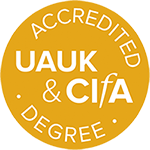
Archaeological science and globalisation: Great Zimbabwe
For over three hundred years before European colonisation, Great Zimbabwe (AD 1250-1600) was widely networked, directly and indirectly, with the Indian Ocean Rim regions of Africa and Asia. On its part, Great Zimbabwe supplied gold, iron, ivory and other commodities that were in demand in Asia. In return, it received tin bronzes and brasses, glass beads and imported ceramics. In the process, technologies and materials were exchanged and re-contextualised to suit local purposes, thereby transforming the global into the local, and the local into the global.
However, it is not clear how local commodities such as gold were manipulated both socially and technically. Furthermore, were imported alloys such as bronze worked using indigenous or foreign techniques? Although answers to such questions are essential for exploring interchange of ideas and values, a lack of competency in materials science-based techniques in the region has prevented generations of local researchers from addressing these questions. And yet, their answers have potential to inform a more localised understanding of globalisation.
Fortunately, recent excavations at Great Zimbabwe unearthed finished metal objects and more than 100 crucibles used in various stages of gold, copper and copper alloy production. This project aims to study the crucibles and finished metal objects recovered from Great Zimbabwe World Heritage site using techniques from earth and materials sciences.
While some of the crucibles are specialised, with shapes identical to those found on the East African Coast and in parts of Asia, others resemble domestic pottery. What precipitated the use of differently shaped vessels for working the same metals? Were the crucibles used for the same purposes or in different stages in the productive process? How were foreign materials incorporated in local technological traditions? This project seeks to study these ceramics in order to reconstruct the process technology and to determine whether the clays used to make specialised crucibles and pottery crucibles are all local. This will be complemented by an archaeometallurgical analysis of finished objects from the same excavations.
It is hoped that this research will shed light on imitation, innovation, and technological improvisation within a context of long distance interaction with the Indian Ocean. Dispelling the mistaken belief that Africa was isolated from the rest of the world, this work will investigate Great Zimbabwe’s role in early forms of globalisation based on the Indian Ocean trading and exchange system.
This project is Funded by a Royal Society-Newton Mobility Grant.
Paul Lane, Jasmine Vieri (University of Cambridge)
Shadreck Chirikure (University of Cape Town)
Ezekia Mtetwa (University of Uppsala)
Royal Society-Newton Mobility Grant


